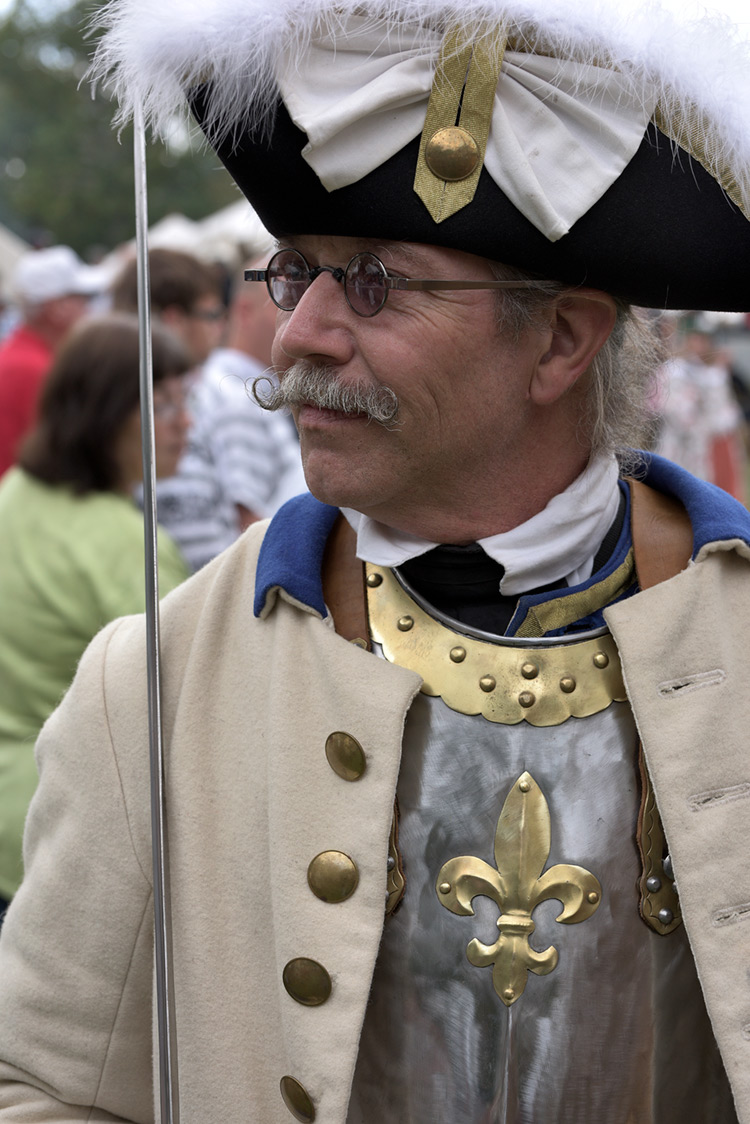Clothing Tips
Some Notes on Living History
“Living History,” through the use of period clothing and through the demonstration of period lifestyles, gives both the participant and the Feast visitor a vivid picture of what Ouiatenon’s past was like. Wear clothing and accoutrements typical of the time and place for your persona. Examples for men include shirts, waistcoats, knee breeches, cocked hats, and hunting shirts. For women, examples include chemises, petticoats, short gown or bed jacket, riding habit, gowns, and coifs and caps. In general, a sleeveless bodice is not considered appropriate and is discouraged. Footwear for men, women and children include colonial-style leather shoes, center-seam moccasins, and bare feet. Children should be dressed comparable to adults. Your camp and all its furnishings, cooking and eating utensils, and foods need to be correct for our place and period. Any modern equipment, such as coolers, should be kept out of sight at all times. Keep your tent flap closed if you have non-period items inside. Examples of appropriate cookware/tableware include bone, wood, or horn handled or forged utensils; brass/copper/tin cooking pots, round-bottomed cast iron kettles; wooden/pewter/pottery/tin plates, bowls, cups or mugs. All beverages need to be in period containers.
 Native Americans
Native Americans
The French selected the site in part because just across the Wabash River was a large Wea Indian village. The Weas were a part of the Miami tribes who had settled in five villages on the banks of the Wabash below the mouth of the Tippecanoe River. Their location was the gateway to the western prairies for various other tribes including the Kickapoos, Mascoutens, Sauk, and Fox.
Native camps should not have camp furniture. Indian portrayals should wear Eastern Woodlands Indian dress of the period.
 Voyageurs
Voyageurs
The voyageurs interpret the lifestyle of 18th century canoemen. French voyageurs annually descended the Wabash to trade their goods for furs trapped by the Native people. Some remained there to establish homes.
Voyageurs may register as independents or with a brigade. They may participate in the canoe landings and races.
 Habitants
Habitants
The habitants interpret the lives of French settlers. French settlers came to the area to trade and to serve as craftspeople and artisans to promote the growth of the post. Around the walls of the fort were as many as 90 houses of French and Natives. At its height there may have been as many as 2,000 to 3,000 inhabitants in the general area. The habitant interpretation area is near the artillery park.
 Military
Military
The Forces of Montcalm and Wolfe, Seven Years War, Inc. and the Northwest Territory Alliance are the re-enactors of military life & battles at Ouiatanon. French Marines came from Vincennes to help keep the peace at this rough frontier outpost. Ouiatenon saw military action during the French and Indian War, Pontiac’s Uprising and the American settlement period.
Registration is done by the Unit Commander. Independent units should consult with the Feast Coordinator for more information on registration.
 Merchants
Merchants
The fur trade was one of the main reasons the post was created. The merchants within the post walls and sold goods of all sorts imported from Europe or made in Canada. Cloth, jewelry, and cooking ware were some of the more important items. Other traders went into the region, trading with the Native peoples. Craftspeople were also important, making items that were not imported, including blacksmiths and other artisans.
Learn More About Living History and Ouiatenon
Ouiatanon & The French
Ouiatanon Documents Chien Noir Trading Co
Balesi, Charles. The Times of the French in the Heart of North America
Johnson, Mary Moyars. Ouiatanon: The French Post Among the Ouia.
Living History / Clothing
Baumgarten, Linda. What Clothes Reveal
Baumgarten, Linda. Clothing Construction and Pattern 1750-1790.
Burnston, Sharon Ann. Fitting and Proper (Scurlock, 1999).
Forbes, Judy, Mary Moyars Johnson, and Kathy Delaney. Historic Colonial French Dress
Gilgun, Beth. Tidings from the 18th Century Crock Pub Co;1993.
Grousse, Suzanne and Andre. Costume in New France from 1740-1760 Ft. Chambly, Canada.
Roth, Stacy Flora. Past Into Present: Effective Techniques for First-Person Historical Interpretation University of North Carolina Press, 1998.
Wright, Frances. Everyday Dress of Rural America, 1783-1800 : With Instructions and Patterns. Dover, 1992
